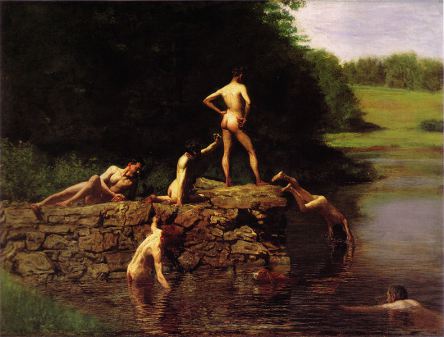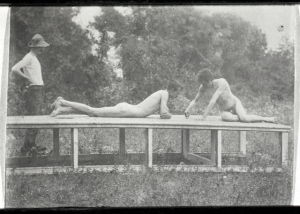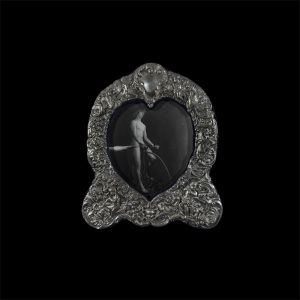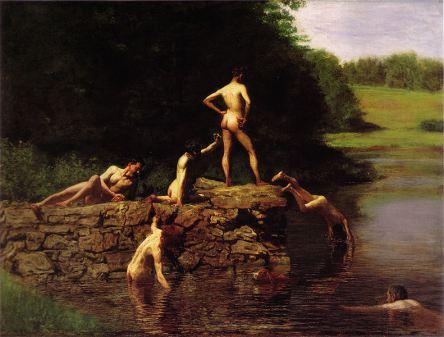Inside the exhibition Manly Pursuits: The Sporting Images of Thomas Eakins is a gallery of works by contemporary artist Tad Beck, whose exhibition Palimpsest, works in dialogue with Eakins’s paintings and photographs. We asked Tad to guest blog on Unframed today, connecting the dots between the two shows.
During the installation of my exhibition Palimpsest, I was able to have my own private exploration of Manly Pursuits. I had never seen many of these works in person, though Eakins has been one of my primary influences since parallels emerged with my own practice. The first similarities appeared between my video installation, Roll (2003) and Eakins’s painting The Swimming Hole (1884–85). Both Eakins’s and my own work focus on nude models. The locations look very much the same, and both Eakins and I are treading water. There was even similar passion for creating axis. While none of these parallels were intentional in Roll, they became definitive and almost seemed beyond coincidence.
[vimeo http://www.vimeo.com/13802117 w=444&h=333]

Thomas Eakins, The Swimming Hole, 1884–85, Amon Carter Museum, Fort Worth, Texas, Purchased by the Friends of Art, Fort Worth Art Association, 1925; acquired by the Amon Carter Museum, 1990, from the Modern Art Museum of Fort Worth through grants and donations from the Amon G. Carter Foundation, the Sid W. Richardson Foundation, the Anne Burnett and Charles Tandy Foundation, Capital Cities/ABC Foundation, Fort Worth Star-Telegram, The R. D. and Joan Dale Hubbard Foundation and the people of Fort Worth
Palimpsest was created in part to examine my connection to Eakins, to make the parallels a primary issue in my creative process. Brian Allen of the Addison Gallery of American Art had given me reproductions of the Circle of Eakins’ Grafly Album, which provided me with images that evoked an artist/model dynamic I was very interested in. I shot the Palimpsest models in my own studio, simulating the light of Eakins’s studio and reenacting the poses of Eakins’s models. My models were then digitally inserted into Eakins’s studio.
Despite the consuming installation of my own photographs, I was struck by one of Eakins’s works in particular—Male Clothed, Standing, and Male Nude Named J. Laurie Wallace Nude, Reclining on Platform in Wooded Landscape (1883). This photograph is a study for The Swimming Hole, but it was not shot at the swimming hole; rather at an entirely unrelated location and time with the figures posing on a constructed stage that simulated the perspective and lighting of the location in the painting and other photographs.

Thomas Eakins, Male Clothed, Standing, and Male Nude Named J. Laurie Wallace Nude, Reclining on Platform in Wooded Landscape, c. 1883, The Pennsylvania Academy of the Fine Arts, Charles Bregler’s Thomas Eakins Collection. Purchased with the partial support of the Pew Memorial Trust, 1985.68.2.476
One of the model’s poses in this image is seen in the painted Study for Swimming Hole. While it is clear that Eakins used photographs to paint from, this photograph represents the more complicated strategy of a self-aware cinematic or fictional use of photography that really came into critical discussion in the Pictures generation. It is not just a photographic moment to be reproduced in paint. In ways it resembles the photographs I initially shot before I digitally inserted my models into Eakins’s studio in Palimpsest. The figures are engaged in an activity that does not match their background or their time, primed for insertion into a fictional or constructed scene made up of various other photographic moments.
Although some may have issue with Eakins painting from photographs, I have no qualms with it, rather I celebrate him for it. My real interest is in Eakins’s relationship to what photography does, to what the choreographed and assembled reality that photography provided him. Surprisingly I found myself even more closely aligned with Eakins because of a contemporary method that requires the artist to unify a variety of moments into one realistic composition. As viewers, we are able to embrace the fiction of that warm afternoon swimming, but also the reality of each ingredient of the composite seen in the accompanying photographs. This duality is at the heart of Palimpsest and apparently The Swimming Hole as well.

Tad Beck, Palimpsest One, 2009, courtesy the artist
Tad Beck



